
The Archbishop of Cologne is an archbishop representing the Archdiocese of Cologne of the Catholic Church in western North Rhine-Westphalia and northern Rhineland-Palatinate in Germany and was ex officio one of the electors of the Holy Roman Empire, the Elector of Cologne, from 1356 to 1801.

The Diocese of Mainz, historically known in English by its French name of Mayence is a Latin rite of the Catholic church in Germany. It was founded in 304, promoted in 780 to Metropolitan Archbishopric of Mainz and demoted back in 1802 to bishopric. The diocese is suffragan diocese in the ecclesiastical province of the Metropolitan Archdiocese of Freiburg. Its district is located in the states of Rhineland-Palatinate and Hesse. The seat of the diocese is in Mainz at the Cathedral dedicated to Saints Martin and Stephen. It is the only Roman Catholic diocese in the world – other than Rome – which bears the title of a Holy See.

The Diocese of Passau is a Roman Catholic diocese in Germany that is a suffragan of the Archdiocese of Munich and Freising. Though similar in name to the Prince-Bishopric of Passau—an ecclesiastical principality that existed for centuries until it was secularized in 1803—the two are entirely different entities. The diocese covers an area of 5,442 km².
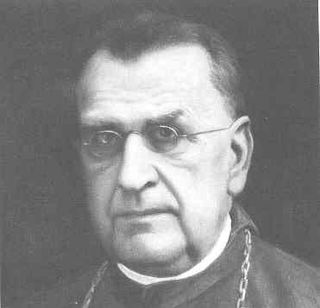
Michael Heiss was a German-born prelate of the Roman Catholic Church who served as the first Bishop of the Diocese of La Crosse (1868–1880) and the second Archbishop of the Archdiocese of Milwaukee (1881–1890).

Érard de la Marck was prince-bishop of Liège from 1506 till 1538. He was born in Sedan, Ardennes, the third son of Robert I de la Marck, lord of Sedan and Bouillon.
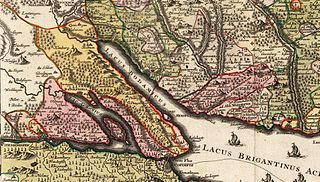
The Prince-Bishopric of Constance, was a small ecclesiastical principality of the Holy Roman Empire from the mid–12th century until its secularisation in 1802–1803. In his dual capacity as prince and as bishop, the prince-bishop was also in charge of the considerably larger Roman Catholic Diocese of Konstanz, which existed from about 585 until its dissolution in 1821. It belonged to the ecclesiastical province of Mainz since 780/782.
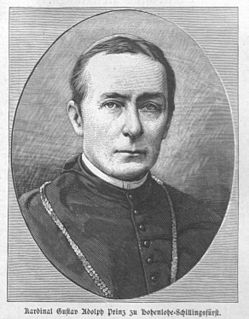
Gustav Adolf, Cardinal Prince of Hohenlohe-Schillingfürst, (1823–1896) was a member of the Hohenlohe family of Germany, claiming descent from Eberhard, one of the early dukes of Franconia. He became a cardinal of the Catholic Church.

The Roman Catholic Archdiocese of Zadar is an archdiocese of the Latin Rite of the Roman Catholic church in Croatia. The diocese was established in the 3rd century AD and was made an archdiocese by the Pope Anastasius IV in 1154. Today, it is not part of any ecclesiastical province of Croatia but is only Croatian Archdiocese subjected directly to the Holy See.
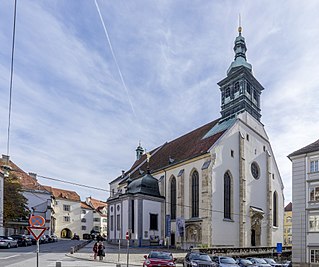
The Roman Catholic Diocese of Graz-Seckau is a diocese comprising the Austrian state of Styria. It is part of the ecclesiastical province of Salzburg.

The Prince-Bishopric of Minden was an ecclesiastical principality of the Holy Roman Empire. It was progressively secularized following the Protestant Reformation when it came under the rule of Protestant rulers, and by the Peace of Westphalia of 1648 given to Brandenburg as the Principality of Minden. It must not be confused with the Roman Catholic diocese of Minden, which was larger, and over which the prince-bishop exercised spiritual authority.
The Bishopric of Culm was a Roman Catholic diocese in Chełmno Land, founded in medieval Prussia in 1243 and disbanded in 1992.

The Roman Catholic Diocese of Tournai is a diocese of the Latin Rite of the Roman Catholic church in Belgium. The diocese was formed in 1146, upon the dissolution of the diocese of Noyon & Tournai, which had existed since the 7th century. It is now suffragan of the archdiocese of Mechelen-Brussels. The cathedral is Notre-Dame de Tournai which has been classified both as a Wallonia's major heritage since 1936 and as a World Heritage Site since 2000.
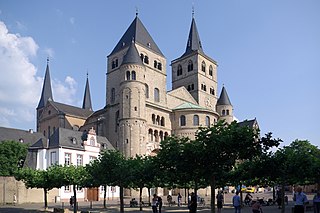
The Roman Catholic diocese of Trier, in English traditionally known by its French name of Treves, is a diocese of the Latin Rite of the Roman Catholic church in Germany. When it was the archbishopric and Electorate of Trier, it was one of the most important states of the Holy Roman Empire, both as an ecclesiastical principality and as a diocese of the Church. Unlike the other Rhenish dioceses — Mainz and Cologne, Trier was the former Roman provincial capital of Augusta Treverorum. Given its status, Trier has always been the seat of a bishop since Roman times, one of the oldest dioceses in all of Germany. The diocese was elevated to an archdiocese in the time of Charlemagne and was the metropolitan for the dioceses of Metz, Toul, and Verdun. After the victory of Napoleon Bonaparte of France, the archdiocese was lowered to a diocese and is now a suffragan of the Archdiocese of Cologne. The diocesan cathedral is the Cathedral of Saint Peter.
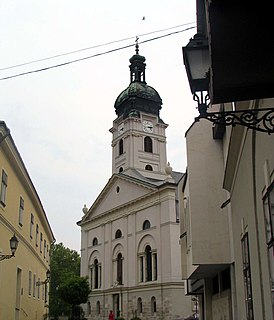
The Roman Catholic Diocese of Győr is a diocese of the Latin Rite of the Roman Catholic Church in Hungary. The diocese is suffragan to the Archdiocese of Esztergom-Budapest. The diocese is believed to have been established in 1009 by King Stephen I of Hungary, along with most of the other Hungarian dioceses.

Hugo Eberhard Kratz von Scharfenstein was the Prince-Bishop of Worms from 1654 to 1663.
Egidio Colonna, O.S.B. or Carlo Colonna was a Roman Catholic prelate who served as Titular Patriarch of Jerusalem (1671–1686) and Titular Archbishop of Amasea (1643–1671).
Eberhard von Holle was bishop of Lübeck from 1561, also abbot of the Michaelis monastery in Lüneburg and administrator of the diocese of Verden from 1564.













